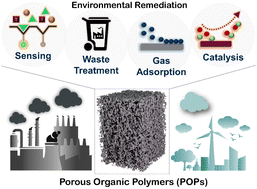Porous organic polymers (POPs) for environmental remediation†
Abstract
Modern global industrialization along with the ever-increasing growth of the population has resulted in continuous enhancement in the discharge and accumulation of various toxic and hazardous chemicals in the environment. These harmful pollutants, including toxic gases, inorganic heavy metal ions, anthropogenic waste, persistent organic pollutants, toxic dyes, pharmaceuticals, volatile organic compounds, etc., are destroying the ecological balance of the environment. Therefore, systematic monitoring and effective remediation of these toxic pollutants either by adsorptive removal or by catalytic degradation are of great significance. From this viewpoint, porous organic polymers (POPs), being two- or three-dimensional polymeric materials, constructed from small organic molecules connected with rigid covalent bonds have come forth as a promising platform toward various leading applications, especially for efficient environmental remediation. Their unique chemical and structural features including high stability, tunable pore functionalization, and large surface area have boosted the transformation of POPs into various macro-physical forms such as thick and thin-film membranes, which led to a new direction in advanced level pollutant removal, separation and catalytic degradation. In this review, our focus is to highlight the recent progress and achievements in the strategic design, synthesis, architectural-engineering and applications of POPs and their composite materials toward environmental remediation. Several strategies to improve the adsorption efficiency and catalytic degradation performance along with the in-depth interaction mechanism of POP-based materials have been systematically summarized. In addition, evolution of POPs from regular powder form application to rapid and more efficient size and chemo-selective, “real-time” applicable membrane-based application has been further highlighted. Finally, we put forward our perspective on the challenges and opportunities of these materials toward real-world implementation and future prospects in next generation remediation technology.

- This article is part of the themed collection: Recent Review Articles


 Please wait while we load your content...
Please wait while we load your content...